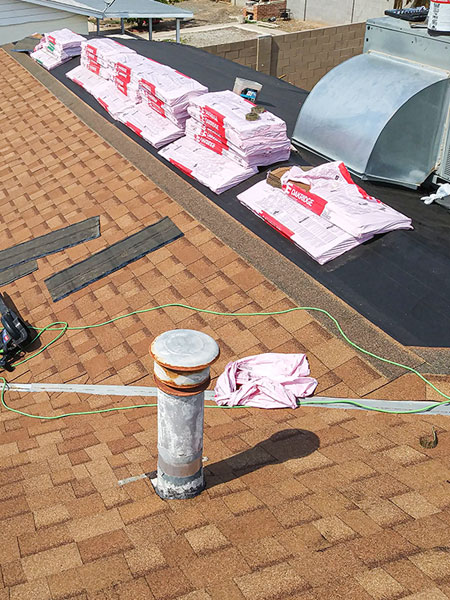The use of synthetic underlayment on a residential roof is becoming an increasingly popular choice among homeowners.
Synthetic underlayment offers several advantages over traditional felt and asphalt-saturated paper, making it the superior option for many installation projects.
This article will provide readers with an overview of the benefits associated with using this type of product in their next roofing project.
By exploring why synthetic underlayment is often preferred, readers can gain a better understanding of the potential cost savings as well as improved peace of mind that comes from choosing this durable material for their roofs.
Additionally, readers will learn about how to select the best product for their needs and understand what steps need to be taken in order to ensure that they are getting the most out of their investment.
Durability And Longevity
Synthetic underlayment provides a high level of durability and longevity when used in residential roofing. It is designed to withstand weather elements such as rain, snow and extreme temperatures, providing superior protection for the roof compared to other types of materials.
Synthetic underlayment also has excellent resistance against mold and mildew growth due to its synthetic composition which makes it more resistant than traditional felt paper or tar paper. Additionally, because it’s made from polypropylene material, synthetic underlayment can last up to ten years with proper maintenance while felt paper or tar paper may need replacing after five years.
Using synthetic underlayment on a residential roof will result in fewer repairs over time and require less maintenance overall. This is because the material does not deteriorate as quickly as other materials do, making it an ideal choice for homeowners who want their roofs to remain protected for longer periods of time without frequent upkeep.
The installation process is quick and easy too, so homeowners are able to enjoy the benefits immediately with minimal effort on their part.

Cost Savings
Synthetic underlayment provides a cost-effective solution for residential roofing. It can be installed quickly and efficiently, reducing the labor costs associated with traditional felt paper and more time consuming materials like asphalt saturated papers.
The synthetic material is lightweight but tough, providing superior protection against water penetration while requiring minimal maintenance.
The use of synthetic underlayment also results in significant long-term savings compared to other options. Due to its durability, it does not need to be replaced as frequently as some alternatives, resulting in fewer repair or replacement costs over the life of the roof.
Additionally, since there are no organic components present in synthetic underlayment, there is less risk of degradation from exposure to sunlight and temperature extremes over time. This further reduces future expenses related to repairs or replacements due to wear and tear on the material itself.
Synthetic underlayment thus offers an economical choice that will pay dividends throughout its lifetime.
Improved Performance
Synthetic underlayment has become a popular choice for residential roofing due to its enhanced performance capabilities. The material is strong, flexible, and durable, providing long-term protection that traditional felt paper cannot match. It can also be installed quickly with minimal effort by one or two people, saving time and money on labor costs compared to other types of underlayment.
Waterproofing properties are another key benefit of synthetic underlayment – the material’s ability to provide reliable protection from water intrusion when properly installed makes it an ideal option for areas prone to high levels of moisture.
Additionally, synthetic underlayment offers superior resistance against mold growth and mildew formation which helps ensure the integrity of the entire roof system over time. These features combine to create a product that provides exceptional value in terms of both cost savings and longer-lasting performance than other alternatives available today.
Easy Installation
Synthetic underlayment is a great choice for residential roofing projects due to its ease of installation. This type of material requires no specialized tools and can be installed quickly, even with just one person.
It also has superior strength compared to other types of materials, which further simplifies the process of laying it down on top of the deck boards or sheathing. Additionally, synthetic underlayment does not require any specific orientation or direction when being laid; this makes it much easier for installers to use than traditional felt paper or asphalt shingles that must follow certain patterns during application.
This type of underlayment has excellent water-resistant properties as well and helps protect against moisture damage in extreme weather conditions. Furthermore, since synthetic underlayment is lightweight and easy to handle, it also reduces labor costs associated with installing heavier materials like metal flashing or tile roofs.
Other benefits include improved air flow beneath the roof, increased energy efficiency and greater protection from UV rays that can cause fading over time. Synthetic underlayment offers a variety of advantages that make it an ideal choice for residential roofing projects.
Environmental Benefits
Synthetic underlayment has become increasingly prevalent in residential roofing applications. Its eco-friendly design provides countless environmental benefits, making it an attractive choice for those seeking to reduce their negative footprint on the environment.
The use of synthetic underlayment helps decrease energy bills by increasing a home’s overall thermal performance and providing superior protection against air infiltration.
Additionally, due to its lightweight construction, installation requires fewer materials than traditional felt paper or asphalt shingles, reducing the amount of waste created during the process.
Moreover, many varieties are made from recycled content that is both non-toxic and free of any hazardous chemicals that can pollute landfills and water sources.
Synthetic underlayment also serves as a reliable waterproof barrier that prevents moisture intrusion through the roof deck and protects building structures from rot damage caused by extreme weather conditions such as hail storms and high winds. In turn, this increases the longevity of roofs without forcing homeowners into costly repairs or replacements down the line.
In summary, using synthetic underlayment in residential roofing applications offers numerous advantages with regard to energy efficiency, reduced waste production, sustainability, and enhanced durability over time – all of which result in better protection for both homes and environments alike.
Fire Resistance
In addition to its environmental benefits, synthetic underlayment can also provide fire resistance to a residential roof. Synthetic underlayment is composed of polypropylene or polyethylene which serves as an effective flame retardant and helps protect the roof from high heat temperatures. This material has been tested for flammability and found to be extremely resistant; it does not burn easily nor support combustion in any way when exposed to high levels of heat.
As such, homeowners who choose this type of underlayment will have peace of mind knowing their home is protected in the event of a sudden fire due to inflammable materials being stored nearby or other potential risks.
Synthetic underlayment also offers additional protection against water damage caused by hurricanes and heavy rains. The material’s waterproof properties help prevent moisture seeping into your home, thereby protecting both your interior walls and ceiling from major structural damages due to flooding or rainwater accumulation on the roof.
Additionally, synthetic underlayment can help extend the life of your shingles because it prevents UV radiation from reaching them directly thus minimizing any potential fading or cracking that could occur over time. Ultimately, these factors make choosing synthetic underlayment an ideal option for those looking for reliable fire-resistance and increased durability for their roofs.

Selecting The Right Product
Synthetic underlayment provides superior protection compared to traditional felt paper and is the preferred option for residential roof installation. It’s designed with a high tear resistance and durable membrane that resists water penetration, making it an ideal choice for areas prone to heavy rain or severe snowfall.
When selecting the right product for your residential roof, there are several factors to consider, such as which type of synthetic material you choose and how much coverage your roof will require.
Two popular types of synthetic underlayment materials used in roofing projects include non-woven polypropylene and spunbonded olefin fabrics. Non-woven polypropylene has excellent breathability while providing superior strength and durability, whereas spunbonded olefin fabric offers great flexibility at low temperatures without sacrificing its waterproof capabilities. Both options provide superior protection when installed properly according to manufacturer instructions.
Ultimately, the best product depends on your specific needs—consult a professional contractor if necessary before deciding which one is most suitable for your home.
Conclusion
Synthetic underlayment is a great choice for residential roofs due to its various advantages.
It provides improved performance, cost savings, durability and longevity, easy installation as well as environmental benefits and fire resistance when compared to traditional felt paper products.
When selecting the right product it is important to consider factors such as the weather in which it will be installed and the slope of the roof so that it can provide optimal protection against water infiltration.
Synthetic underlayment offers an ideal solution for many homeowners looking for superior roofing material that lasts longer, performs better and costs less over time than traditional options.


